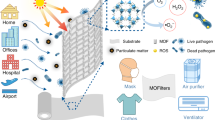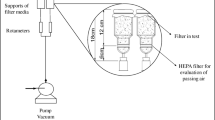Abstract
Photocatalytic oxidation (PCO) has been described as an advanced technology to remove toxic volatile organic compounds (VOCs) and airborne microorganisms from indoor air environments. This technique is economic, stable, safe, and capable to remove a wide variety of organic contaminants under UV irradiation. This study presents a case study on the effect of a fabricated filter in the removal of toluene at 26 mg/L and disinfection of ambient air under a given operating condition. The principal goals of this study were to synthesize Ag nanoparticles/TiO2 filter for the first time via the deposition of Ag nanoparticles on a commercial immobilized TiO2 tissue sheet by impregnation technique and to investigate the performance of this prepared Ag/TiO2 tissue based filter system for toluene removal as well as to remove airborne microorganisms from indoor air. The results illustrated that under the experimental conditions, Ag/TiO2-based filter was able to disinfect well the microorganisms. The performance of Ag/TiO2 filter shows two different stages; the first one is a slight adsorption phase in dark with approximately 15% of toluene removal within 60 min. The second stage is a photooxidation phase under UV irradiation in which the toluene removal efficiency was significantly enhanced with extension of the operational time and reached 97% during this stage. Additionally, the Ag/TiO2 filter has a higher disinfection capacity of airborne microorganisms that completely removed to reach 100% after 300 min of application. This filter could be practically introduced as an effective system in industrial, hospital, and home applications for air purification.

Graphical abstract









Similar content being viewed by others
References
Abidi M, Assadi AA, Bouzaza A, Hajjaji A, Bessais B, Rtimi S (2019) Photocatalytic indoor/outdoor air treatment and bacterial inactivation on CuxO/TiO2 prepared by HiPIMS on polyester cloth under low intensity visible light. Appl Catal B Environ 259:118074
Andriantsiferana C, Mohamed EF, Delmas H (2014) Photocatalytic degradation of an azo-dye on TiO2/activated carbon composite material. Environ Technol 35(3):355–363
Andriantsiferana C, Mohamed EF, Delmas H (2015) Sequential adsorption photocatalytic oxidation process for wastewater treatment using a composite material TiO2/activated carbon. Environ Eng Res 20(2):181–189
Awad G, Mohamed EF (2019) Immobilization of P450 BM3 monooxygenase on hollow nanosphere composite: application for degradation of organic gases pollutants under solar radiation lamp. Appl Catal B Environ 253:88–95
Awad G, Mathieu F, Coppel Y, Lebrihi A (2005) Characterization and regulation of new secondary metabolites from Aspergillus ochraceus M18 obtained by UV mutagenesis. Can J Microbiol 51(1):59–67
Bakheet AA, Mohd Zain MF, Kadhum AA, Abdalla Z (2011) Photocatalytic oxidation performance to removal of volatile organic compounds in indoor environment. Environ Res Eng Manag 4(58):27–33
Binas V, Venieri D, Kotzias D, Kiriakidis G (2017) Modified TiO2 based photocatalysts for improved air and health quality. J Mater 3(1):3–16
Blake DM, Maness P-C, Huang Z, Wolfrum EJ, Huang J (1999) Application of the photocatalytic chemistry of titanium dioxide to disinfection and the killing of cancer cells. Separation Purification Methods 28(1):1–50
Das J, Rene ER, Krishnan J (2018) Photocatalytic degradation of volatile pollutants. J Environ Chem Toxicol 2(2):57–59
Foster HA, Ditta IB, Varghese S, Steele A (2011) Photocatalytic disinfection using titanium dioxide: Spectrum and mechanism of antimicrobial activity. Appl Microbiol Biotechnol 90(6):1847–1868
Gupta K, Singh RP, Pandey A, Pandey A (2013) Photocatalytic antibacterial performance of TiO2 and Ag-doped TiO2 against S. Aureus. P. Aeruginosa and E. Coli. Beilstein J Nanotechnol 4:345–351
Hajjaji A, Elabidi M, Trabelsi K, Assadi AA, Bessais B, Rtimi S (2018) Bacterial adhesion and inactivation on Ag decorated TiO2-nanotubes under visible light: Effect of the nanotubes geometry on the photocatalytic activity. Colloids Surf B: Biointerfaces 170:92–98
Handoko CT, Moustakas NG, Peppel T, Springer A, Oropeza FE, Huda A, Bustan MD, Yudono B, Gulo F, Strunk J (2019) Characterization and effect of Ag (0) vs. Ag (I) species and their localized plasmon resonance on photochemically inactive TiO2. Catalysts 9(323):1–16
Hecht E (2002) Optics, 4th edn. Pearson Inc, San Francisco
Huang Z, Mannes PC, Blake DM, Wolfrum EJ, Smolinski SL, Jacoby WA (2000) Bactericidal mode of titanium dioxide photocatalysis. J Photochem Photobiol A Chem 130(2–3):163–170
Huang Y, Sai S, Ho H, Lu Y, Niu R, Xu L, Cao J, Lee S (2016) Removal of indoor volatile organic compounds via photocatalytic oxidation: a short review and prospect. Molecules 21(1):56
Jiang X, Lv B, Wang Y, Shen Q, Wang X (2017) Bactericidal mechanisms and effector targets of TiO2 and Ag-TiO2 against Staphylococcus aureus. J Med Microbiol 66(4):440–446
Kim KS, Lee D, Song CG, Kang PM (2015) Reactive oxygen species-activated nanomaterials as theranostic agents. Nanomedicine (London) 10(17):2709–2723
Kowalski WJ (2006) Photocatalytic oxidation. Aerobiological engineering handbook (pp. 295). United States: the McGraw-Hill Companies, Inc
Lebret E, van de Wiel HJ, Bos HP, Noij D, Boleij JSM (1986) Volatile organic compounds in Dutch homes. Environ Int 12:323–332
Lim M, Zhou Y, Wang L, Rudolph V, Lu GQ (2009) Development and potential of new generation photocatalytic systems for air pollution abatement: an overview. Asia Pac J Chem Eng 4:387–402
Maness P, Smolinski S, Blake DM, Huang Z, Wolfrum EJ, Jacoby WA (1999) Bactericidal activity of photocatalytic TiO2 reaction: toward an understanding of its killing mechanism. Appl Environ Microbiol 65(9):4094–4098
Mohamed EF (2011) Removal of organic compounds from water by adsorption and photocatalytic oxidation. PhD, Institut National Polytechnique de Toulouse, 2011
Mohamed EF, Awad G, Andriantsiferana C, El-Diwany AI (2016) Biofiltration technology for the removal of toluene from polluted air using Streptomyces griseus. Environ Technol 37(10):1197–1207
Montero-Montoya R, López-Vargas R, Arellano-Aguilar O (2018) Volatile organic compounds in air: sources, distribution, exposure and associated illnesses in children. Ann Glob Health 84(2):225–238
Novak TN, Šuligoj A, Lavrenčič ŠU (2018) TiO2/SiO2 films for removal of volatile organic compounds (VOCs) from indoor air. In: Martínez L, Kharissova O, Kharisov B (eds) Handbook of ecomaterials. Springer, Cham, pp 1–17
Panagiotaras D, Nikolopoulos D, Petraki E, Kottou S, Koulouglioti D, Yannakopoulos P, Kaplanis S (2014) Comprehensive experience for indoor air quality assessment: a review on the determination of volatile organic compounds (VOCs). J Phys Chem Biophys 4:2–12
Podporska-Carroll J, Myles A, Quilty B, McCormack D, Fagan R (2017) Antibacterial properties of F-doped ZnO visible light photocatalyst. J Hazard Mater 324(Pt A):39–47
Puzzo DP, Bonifacio LD, Oreopoulos J, Yip CM, Manners I, Ozin GA (2009) Color from colorless nanomaterials: Bragg reflectors made of nanoparticles. J Mater Chem 19:3500–3506
Saranya A, Pandiarajan J, Prithivikumaran N (2016) Synthesis and characterization of TiO2/PS nano structure for sensor applications. Inter J Tech Res App 38:57–60
Schneider J, Matsuoka M, Takeuchi M, Zhang J, Horiuchi Y, Anpo M, Bahnemann DW (2014) Understanding TiO2 photocatalysis: mechanisms and materials. Chem Rev 114(19):9919–9986
Shah KW, Li W (2019) A review on catalytic nanomaterials for volatile organic compounds VOC removal and their applications for healthy buildings. Nanomaterials 9(6):1–23
Shiraki K, Yamada H, Yoshida Y, Ohno A, Watanabe T, Watanabe H, Yamaguchi M, Tokuoka F, Hashimoto S, Kawamura M, Adachi N (2017) Improved photocatalytic air cleaner with decomposition of aldehyde and aerosol-associated influenza virus infectivity in indoor air. Aerosol Air Qual Res 17:2901–2912
Shuai J, Kim S, Ryu H, Park J, Lee CK, Kim G-B, Ultra VU Jr, Yang W (2018) Health risk assessment of volatile organic compounds exposure near Daegu dyeing industrial complex in South Korea. BMC Public Health 18(1):528
Silva CR, Miranda SM, Lopes FVS, Silva M, Dezotti M, Silva AMT, Faria JL, Boaventura RAR, Vilar VJP, Pinto E (2017) Bacteria and fungi inactivation by photocatalysis under UVA irradiation: liquid and gas phase. Environ Sci Pollut Res Int 24(7):6372–6381
Tian F, Wu Z, Yan Y, Ge X, Tong Y (2015) Photodegradation of formaldehyde by activated carbon loading TiO2 synthesized via microwave irradiation. Korean J Chem Eng 32(7):1333–1339
Tsai WT (2019) An overview of health hazards of volatile organic compounds regulated as indoor air pollutants. Rev Environ Health 34(1):81–89
Tsai T-T, Sung W-P, Song W (2011) Identification of indoor airborne microorganisms and their disinfection with combined nano-Ag/TiO2 photocatalyst and ultraviolet light. Environ Eng Sci 28:635–642
Vasilenko MI, Goncharova EN, Rubanov YK, Tokach YE, Nartsev VM (2017) Effect of parameters of production process of photocatalytic coatings on bactericidal property. Adv Eng Res 133:878–883
Wu K-R, Wang J-J, Liu W-C, Chen Z-S, Wu J-K (2006) Deposition of graded TiO2 films featured both hydrophobic and photo-induced hydrophilic properties. Appl Surf Sci 252:5829–5838
Funding
This work was supported by National Research Centre, thank-you for technical support. Funding and laboratory facilities were provided by the Air Pollution Department and Chemistry of Natural and Microbial Products Department of the National Research Centre, Cairo, Egypt.
Author information
Authors and Affiliations
Corresponding author
Ethics declarations
Competing interest
The authors declare that they have no conflict of interest.
Additional information
Responsible Editor: Sami Rtimi
Publisher’s note
Springer Nature remains neutral with regard to jurisdictional claims in published maps and institutional affiliations.
Rights and permissions
About this article
Cite this article
Mohamed, E.F., Awad, G. Photodegradation of gaseous toluene and disinfection of airborne microorganisms from polluted air using immobilized TiO2 nanoparticle photocatalyst–based filter. Environ Sci Pollut Res 27, 24507–24517 (2020). https://doi.org/10.1007/s11356-020-08779-0
Received:
Accepted:
Published:
Issue Date:
DOI: https://doi.org/10.1007/s11356-020-08779-0




